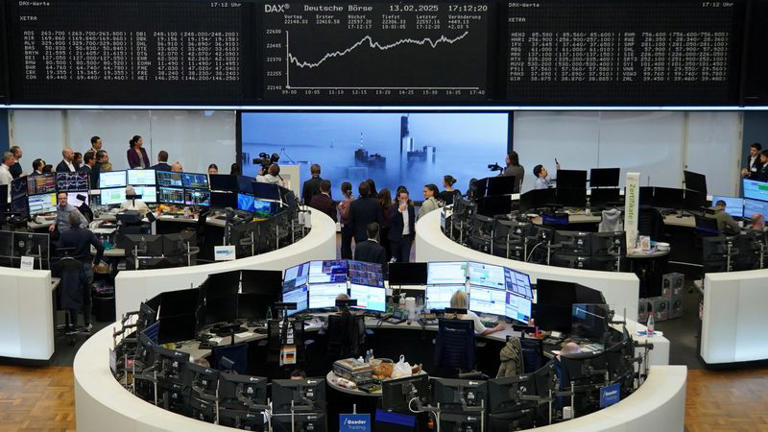Global equity markets rose on Tuesday, with both the S&P 500 and European shares ending at record highs, as markets digested strong U.S. earnings, trade tariffs and a big European defence spending hike.
The benchmark S&P 500 squeaked past its previous record closing high at the top of a holiday-shortened week. All three Wall Street indexes wobbled between red and green for much of the session, but managed to rise in the closing minutes.
European shares ended at a record high, with banking and defence stocks among the top gainers. The pan-European STOXX 600 index hit an all-time high of 557.96.
On Wall Street, all three indexes finished higher after paring losses. Industrials, consumer discretionary, energy, utilities, consumer staples, and financial stocks were the biggest gainers while technology was the main drag.
The Dow Jones Industrial Average rose 0.02% to 44,556.34, the S&P 500 rose 0.24% to 6,129.58 and the Nasdaq Composite rose 0.07% to 20,041.26.
“I think people are still trying to digest everything going on with not only tariffs and how that could impact things but also general valuations,” said Sandy Villere, portfolio manager at Villere & Co in New Orleans. “We feel like the market is pretty expensive.”
China’s stock rally cheering Monday’s rare meeting between President Xi Jinping and domestic business leaders also boosted risk-taking appetite.
European leaders vowed to step up support for Ukraine if U.S.-Russia talks this week lead to a hasty peace deal that compromises Europe’s security.
Investors also hope this weekend’s German election will lead to economic stimulus. Expectations for higher government spending lifted Germany’s benchmark 10-year bond yield to 2.51%, near its highest level of the month.
“That means massive fiscal transformation in Europe,” said John Hardy, global head of macro strategy at Saxo Bank in Denmark. He expected Europe’s STOXX index to outperform Wall Street this year, meanwhile, as investors also fretted about U.S. trade tariffs, inflation and highly valued tech stocks.
Europe’s stock indices are dominated by industrial groups, energy producers and banks and attracted their biggest weekly investment inflow last week since January 2023, Bank of America said.
Key measures of U.S. inflation are also running at a half percentage point or more above the Fed’s goal, with some of its officials arguing to delay rate cuts.
Minutes from the Fed’s January meeting, at which the U.S. central bank held borrowing costs at 4.25% to 4.5%, are due on Wednesday. That follows hawkish comments from Fed Chair Jerome Powell in testimony to Congress last week and hot consumer prices data.
The benchmark U.S. 10-year note yield rose 7.8 basis points to 4.554%.
“You’ve got not only the tariff situation, which I think is going to be more sabre-rattling and negotiating than anything long-term; the other thing is inflation that could be a little more stubborn than people think and I don’t think the Fed can cut interest rates as fast as originally expected,” Villere said.
The dollar advanced against major currencies, with losses led by the euro, garnering safe-haven bids amid tariff concerns and peace negotiations on the Russia-Ukraine conflict.
The dollar strengthened 0.35% to 152.03 against the Japanese yen. Against the Swiss franc, the dollar strengthened 0.28% to 0.903.
The dollar index, which measures the greenback against a basket of currencies including the yen and the euro,rose 0.28% to 107.02, with the euro down 0.31% at $1.0449.
The Australian dollar weakened 0.08% versus the greenback to $0.63515, having been spared blows from the central bank’s first rate cut since 2020 on Tuesday as policymakers delivered it with caution about prospects of further easing.
Brent crude oil settled up 0.82% at $75.84 a barrel as traders awaited the outcome of the U.S.-Russia talks in Riyadh and speculated about potential supply increases if Washington agrees to abandon sanctions on Russian oil.
Spot gold rose 1.23% to $2,933.37 an ounce. U.S. gold futures settled 1.7% higher at $2,949.

